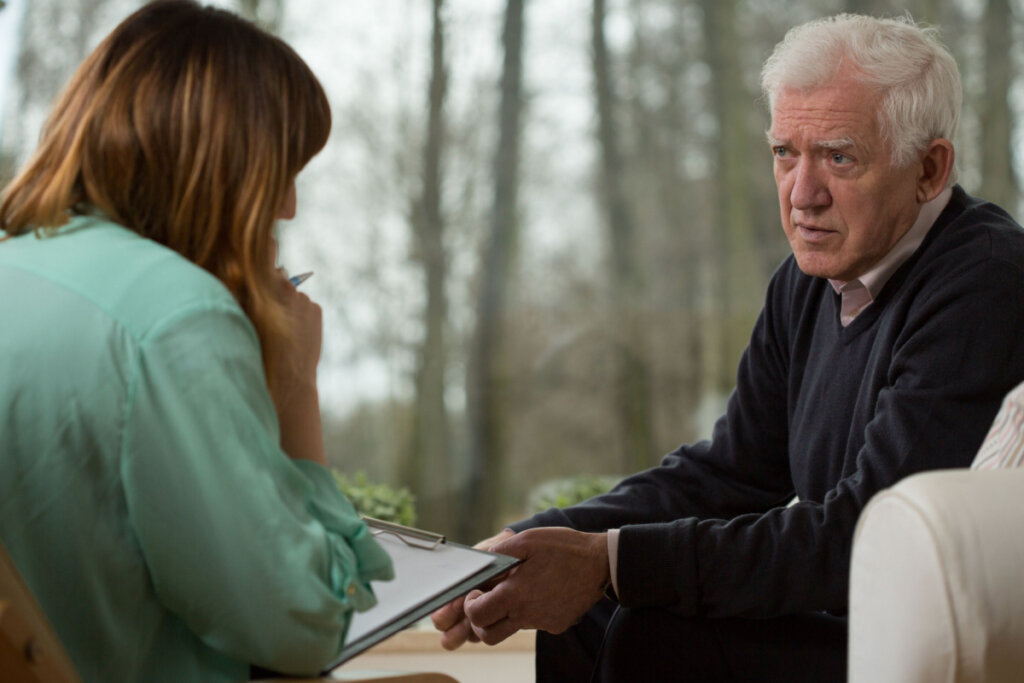Naikan Therapy: The Healing Art of Self-Reflection


Written and verified by the psychologist Valeria Sabater
Self-reflection doesn’t really fit in today’s fast-paced world. Indeed, the ability to go deeper into ourselves and recognize what’s in and out of tune in our lives is a quality that we tend to lack. We usually have no time. And, if we do have it, we choose to spend it watching Netflix and disconnecting from everything around us.
This means that, almost without realizing it, we distance ourselves from our inner spaces that build who we are and the realities that define us. In fact, stress imprisons and suffocates us, and unhappiness from unknown sources appears as we continue to act on automatic pilot. And, the further we move away from ourselves, the closer we get to mental discomfort.
In Japanese, there’s a most inspiring term. It’s known as naikan. It means having the ability to see ourselves with our minds and souls. This concept served as the basis for the creation of a therapeutic school. Despite being over 80 years old, it remains fascinating and useful today.
There comes a time in our lives when we must take stock of where we are and what we’ve been ignoring.

Naikan therapy
It’s often said that Naikan therapy is like climbing the highest peak of a mountain to gain a greater perspective on our lives. From this wide-angle position, we become aware of infinite realities. For instance, we see certain gray areas that we’ve allowed to grow excessively. We also notice territories with great potential that we know we should take advantage of. We may even hear the voice of the wind whispering a secret.
You probably won’t be surprised to learn that this approach originated in the land of the rising sun. In fact, it was Ishin Yoshimoto, a Japanese Buddhist, who laid the foundations for this therapy based on self-reflection, meditation, and the practice of questioning ourselves.
What began in the 40s as an ascetic technique, eventually reached the United States as a therapeutic practice. David K. Reynolds, a faculty member at the University of California School of Public Health, introduced it and created the initial programs.
Naikan therapy is the most popular in Japan. It has its roots in Buddhism.
1. Objectives
Naikan therapy is a resource on which scientific literature and self-help books abound. One example of this is Naikan: Gratitude, Grace, and the Japanese Art of Self-Reflection (2002). Its author, Gregg Krech, explains the goals of this form of therapy. Its main objective is to awaken in the human being the sense of self-reflection.
To achieve this purpose, we must work on three strategic areas:
- Develop deep, significant, and useful knowledge about who we are, what we need, and where we are in our lives.
- Reflect on our relationships with others. We must recognize which ties benefit us and if our interactions with the people we love are appropriate.
- Reflect on the fundamental nature of existence. This is an exercise we may not be used to.
2. Who benefits from Naikan therapy?
Today, there are Naikan centers in major cities all over the world, not just in Japan. The fact that it’s not only endured over time but has emerged as a therapeutic approach worthy of interest, is mainly due to its efficacy in various population groups.
- Naikan therapy is extremely positive for patients with generalized anxiety disorders (GAD) and panic disorders. A study conducted by the University of Tottori (Japan) highlights this fact.
- It’s useful for individuals who are going through moments of crisis, transitions, or vital changes.
- It’s an enriching resource to boost self-esteem and relationships with others and improve personal growth at all levels.
- The fact that it promotes self-reflection can be positive in patients suffering from depression, trauma, etc.
- One field of research is currently evaluating its benefit for the prison population. In fact, Naikan therapy could be helpful in improving self-awareness, personal responsibility, and perception of guilt.
- Intensive therapies are also carried out to solve specific problems. For example, alcoholism, gambling addiction, etc.
The Naikan method invites us to be more grateful. Because valuing who we are and what surrounds us is the best exercise in awareness and self-reflection.

The techniques
We know that Naikan therapy addresses broad areas that range from personal development to more spiritual aspects. However, as a rule, it’s employed for therapeutic purposes and originates from a scientific and empirical basis. It starts with three basic questions that each individual must work on. They’re as follows:
1. Think about the care and support we do or don’t receive from the environment
In the first part of the therapy, the patient is asked the following question: What have you received from…? This premise is a direct invitation to deep reflection on our bonds and daily interactions. It’s not limited only to our families, but we must also open our eyes to the different kinds of scenarios we face on a daily basis.
It helps us to recognize if we’re happy in our relationships, at work, with our friends and families, where we live, etc.
2. Contributions to others
Ishin Yoshimoto, the creator of Naikan therapy, insisted that we should aim to find a vital balance in our lives. To do this, we must think about the following ideas:
- What have we given and received in recent months?
- Are we taking more than we’re offering?
- What do we need from others?
- Think about the actions we carry out daily for the people in our lives and how we feel when carrying them out.
3. The problems and difficulties that we and others cause
One of the goals of this therapy is to become more reflective and also more responsible people. This means that, on the one hand, we must be aware of the suffering we cause to others. On the other, we must realize which relationships or situations cause us more unhappiness than existential balance.
Only then will we wake up and recognize what problems and difficulties are surrounding us. Moreover, we’ll be able to face them in a secure and mature manner.
Looking inside ourselves
People are stories. To write the best life stories, we must know where we want to go. This implies reviewing our lives and the links that surround us.
Only when we’re able to look inside ourselves, are we able to be aware of how to live better on the outside. Naikun therapy can facilitate this objective.
Self-reflection doesn’t really fit in today’s fast-paced world. Indeed, the ability to go deeper into ourselves and recognize what’s in and out of tune in our lives is a quality that we tend to lack. We usually have no time. And, if we do have it, we choose to spend it watching Netflix and disconnecting from everything around us.
This means that, almost without realizing it, we distance ourselves from our inner spaces that build who we are and the realities that define us. In fact, stress imprisons and suffocates us, and unhappiness from unknown sources appears as we continue to act on automatic pilot. And, the further we move away from ourselves, the closer we get to mental discomfort.
In Japanese, there’s a most inspiring term. It’s known as naikan. It means having the ability to see ourselves with our minds and souls. This concept served as the basis for the creation of a therapeutic school. Despite being over 80 years old, it remains fascinating and useful today.
There comes a time in our lives when we must take stock of where we are and what we’ve been ignoring.

Naikan therapy
It’s often said that Naikan therapy is like climbing the highest peak of a mountain to gain a greater perspective on our lives. From this wide-angle position, we become aware of infinite realities. For instance, we see certain gray areas that we’ve allowed to grow excessively. We also notice territories with great potential that we know we should take advantage of. We may even hear the voice of the wind whispering a secret.
You probably won’t be surprised to learn that this approach originated in the land of the rising sun. In fact, it was Ishin Yoshimoto, a Japanese Buddhist, who laid the foundations for this therapy based on self-reflection, meditation, and the practice of questioning ourselves.
What began in the 40s as an ascetic technique, eventually reached the United States as a therapeutic practice. David K. Reynolds, a faculty member at the University of California School of Public Health, introduced it and created the initial programs.
Naikan therapy is the most popular in Japan. It has its roots in Buddhism.
1. Objectives
Naikan therapy is a resource on which scientific literature and self-help books abound. One example of this is Naikan: Gratitude, Grace, and the Japanese Art of Self-Reflection (2002). Its author, Gregg Krech, explains the goals of this form of therapy. Its main objective is to awaken in the human being the sense of self-reflection.
To achieve this purpose, we must work on three strategic areas:
- Develop deep, significant, and useful knowledge about who we are, what we need, and where we are in our lives.
- Reflect on our relationships with others. We must recognize which ties benefit us and if our interactions with the people we love are appropriate.
- Reflect on the fundamental nature of existence. This is an exercise we may not be used to.
2. Who benefits from Naikan therapy?
Today, there are Naikan centers in major cities all over the world, not just in Japan. The fact that it’s not only endured over time but has emerged as a therapeutic approach worthy of interest, is mainly due to its efficacy in various population groups.
- Naikan therapy is extremely positive for patients with generalized anxiety disorders (GAD) and panic disorders. A study conducted by the University of Tottori (Japan) highlights this fact.
- It’s useful for individuals who are going through moments of crisis, transitions, or vital changes.
- It’s an enriching resource to boost self-esteem and relationships with others and improve personal growth at all levels.
- The fact that it promotes self-reflection can be positive in patients suffering from depression, trauma, etc.
- One field of research is currently evaluating its benefit for the prison population. In fact, Naikan therapy could be helpful in improving self-awareness, personal responsibility, and perception of guilt.
- Intensive therapies are also carried out to solve specific problems. For example, alcoholism, gambling addiction, etc.
The Naikan method invites us to be more grateful. Because valuing who we are and what surrounds us is the best exercise in awareness and self-reflection.

The techniques
We know that Naikan therapy addresses broad areas that range from personal development to more spiritual aspects. However, as a rule, it’s employed for therapeutic purposes and originates from a scientific and empirical basis. It starts with three basic questions that each individual must work on. They’re as follows:
1. Think about the care and support we do or don’t receive from the environment
In the first part of the therapy, the patient is asked the following question: What have you received from…? This premise is a direct invitation to deep reflection on our bonds and daily interactions. It’s not limited only to our families, but we must also open our eyes to the different kinds of scenarios we face on a daily basis.
It helps us to recognize if we’re happy in our relationships, at work, with our friends and families, where we live, etc.
2. Contributions to others
Ishin Yoshimoto, the creator of Naikan therapy, insisted that we should aim to find a vital balance in our lives. To do this, we must think about the following ideas:
- What have we given and received in recent months?
- Are we taking more than we’re offering?
- What do we need from others?
- Think about the actions we carry out daily for the people in our lives and how we feel when carrying them out.
3. The problems and difficulties that we and others cause
One of the goals of this therapy is to become more reflective and also more responsible people. This means that, on the one hand, we must be aware of the suffering we cause to others. On the other, we must realize which relationships or situations cause us more unhappiness than existential balance.
Only then will we wake up and recognize what problems and difficulties are surrounding us. Moreover, we’ll be able to face them in a secure and mature manner.
Looking inside ourselves
People are stories. To write the best life stories, we must know where we want to go. This implies reviewing our lives and the links that surround us.
Only when we’re able to look inside ourselves, are we able to be aware of how to live better on the outside. Naikun therapy can facilitate this objective.
All cited sources were thoroughly reviewed by our team to ensure their quality, reliability, currency, and validity. The bibliography of this article was considered reliable and of academic or scientific accuracy.
- Ding X, Liu Z, Cao G, Wei S, Qiu Z, Wang K, Guo X, Di Z, Ren P, Fucha H. The Efficacy of Naikan Therapy on Male Offenders: Changes in Perceived Social Support and Externalized Blame. Int J Offender Ther Comp Criminol. 2018 Aug;62(11):3499-3508. doi: 10.1177/0306624X17742839. Epub 2017 Nov 21. PMID: 29161911.
- Nukina S, Wang H, Kamei K, Kawahara R. [Intensive Naikan therapy for generalized anxiety disorder and panic disorder: clinical outcomes and background]. Seishin Shinkeigaku Zasshi. 2005;107(7):641-66. Japanese. PMID: 16146184.
This text is provided for informational purposes only and does not replace consultation with a professional. If in doubt, consult your specialist.







